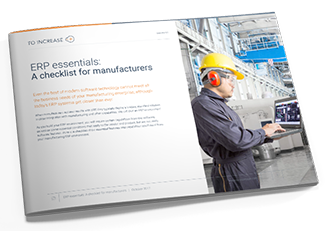Optimizing heavy equipment manufacturing ERP
 Luciano Cunha
Luciano Cunha
Table of contents
Heavy equipment manufacturers make large and complex products, many of them engineer-to-order (ETO) items that often comprise standardized parts and components. Engineering and production need to sync and streamline data and design hand-offs to make sure their output is what the customer wants.However, customers’ requirements may change even when their equipment is already undergoing production. Heavy equipment manufacturers need to have the flexibility to make rapid engineering adjustments and feed them into production without stopping the flow, ruining their margins, or causing waste. A connected, modern manufacturing ERP system can make a huge difference in keeping their efforts productive.Five capabilities are particularly crucial in heavy equipment manufacturing ERP:
-
#1: Engineering management
-
In many heavy equipment manufacturing companies, teams anywhere in the world collaborate to serve customers in a volatile, global economy. The engineering management component of your manufacturing software helps you keep track of changing requirements and scope adjustments along with your resolution for them.In today’s ERP, you can to a high degree standardize and automate the steps of change management and approval, and maintain a smooth workflow from engineering change requests to engineering change orders. To ensure efficient communications and close alignment between engineering and production, ERP should integrate with the product life-cycle management (PLM) system used by engineers.
-
#2: Product configuration management
-
Configuration management lets you project how you are going to meet customer requirements, including all standard and unique production details. You create a viable list of product components after addressing engineering constraints and build an accurate customer quote based.The configuration management tool in your heavy equipment manufacturing ERP has to interface with product engineering to support the full configure, price, quote (CPQ) process and refresh data. This is where you establish engineering bills-of-material (EBOM), which often see multiple, customer-prompted revisions before they turn into manufacturing bills-of-materials (MBOM). Given current, reliable configuration source data, quoting errors are unlikely.Product configuration should connect with the financials and sales modules in your ERP system, so forecasting and planning can rely on dependable revenue and profit projections. Manufacturing ERP can allow seamless transitions among BOM iterations and from engineering, to CPQ, to production.
-
#3: Project management
-
Many heavy equipment manufacturers don’t produce standardized items, but run their business based on ERP-facilitated projects. Engineering designs, quotes, EBOMs and MBOMs, and production support specific project goals for profitability, quality, budgets, and delivery schedules.Today’s manufacturing software lets you control the many moving elements of production projects, with planning and tracking functionality for all resources, materials, milestones, and activities. You can simplify planning with visually optimized, intuitive tools that translate engineering and quote details into project workflows. You can save projects as templates and re-purpose them, improving your delivery over time.Heavy equipment manufacturing ERP gives you the visibility to make immediate adjustments if customer needs change, and calculates the consequences for finance and resource management. It also should support your preferred project management methodology and accounting practice, such as earned value management (EVM).
-
#4: Asset management
-
Your manufacturing ERP solution gives you a framework for collecting and analyzing all the data and histories associated with your production machinery, equipment, specialized vehicles, fleets, facilities, and other industrial assets. Cloud analytics tools can enhance the ERP software to make it easier to understand this data and ensure the best possible returns from your assets.Based on data insight, you can perform preventive maintenance. You keep machinery running at best performance levels without unplanned disruptions that cut into your productivity or jeopardize customer commitments. Heavy equipment manufacturing ERP also lets you track asset-related KPIs, including Overall Equipment Effectiveness (OEE).
-
#5: Asset service management
-
Even if you do nothing more than provide warranty services under contract, ERP helps you keep service financials in the black and lets you get the right technicians to customer sites at the right times. If you offer more comprehensive services to improve the business outcomes your customers achieve with your products, a modern ERP solution is essential in targeting the right customers and delivering services in a profitable and efficient manner.Your field service technicians can go from one assignment to the next without spending unproductive time recording their activities and researching customer data at an office location. Cloud-based manufacturing ERP is perfect for mobile access from anywhere.
With these five capabilities in your manufacturing operation, you can reach revenue, growth, and customer retention goals faster and easier. Some manufacturers accomplish this in an ERP environment optimized for heavy equipment manufacturing, integrating Microsoft Dynamics 365 and the STAEDEAN manufacturing suite. It provides these essential capabilities and much more.If you want to make a closer match between your requirements and what your manufacturing ERP solution needs to provide, Download Our ERP Essentials Checklist below


-1.png?width=800&name=Blog%20Hero%20Image%20(3)-1.png)